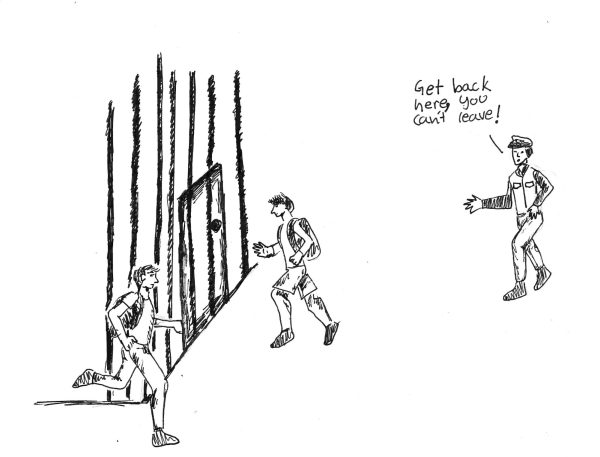Misgendering, and the Harm Trans Students Face in School
Clarion photo Theo Chowdry
A trans student at Cleveland describes being misgendered as something that usually involves two factors: your name, and your pronouns. Being dead named is defined as the action of being referred to disrespectfully by a name you no longer go by, usually, a birth name.
Being dead named is a very prevalent issue; it is invalidating, disrespectful, and harmful, especially in high school where identity matters in a crowd of unique individuals. Other than just deadnaming, misgendering can have many different forms like purposefully misusing someone’s pronouns. Pronouns are a crucial part of someone’s identity whether they’re a cis person or a trans person. It defines who they are and how comfortable they are expressing themselves in society. The school system’s approach to making students feel comfortable at school involves mandating respect for their names and pronouns, yet we see that they have not fulfilled this mandate to keep our students safe and generally comfortable.
An issue that I find needs to be highlighted is being dead named during attendance. When registering for the school year, students at Cleveland were allowed to set a preferred name, which was great for the trans students who go to the school. They mentioned feeling hopeful now that their name will finally be used in the classroom and be respected by all students and members of the faculty.
According to The PPS Administrative Directive 4.30.061-A section III-A, “Students of all ages have the right to be addressed by a name and pronouns that correspond to their gender identity. Regardless of whether a transgender or nonbinary student has legally changed their name or gender, students and staff should always use the pronoun and name with which the student identifies or requests.” Yet, Cleveland’s attendance system uses the student’s legal name for attendance rather than their preferred name. This is distressing to the trans students who go to this school. They were promised the ability to have their preferred name recognized, yet for no apparent reason, their legal name instead is what gets called in attendance.
Furthermore, they don’t make it easy for students to even change their legal name on synergy without the permission of a parent or legal guardian. Part of the truth of being queer is knowing that there is a chance that your family might not accept you for who you are, so the process of coming out is inherently difficult emotionally and socially. So, as a result of this system, students are forced to come out if they want the chance to have their correct name be used in schools, when the issue could so easily be avoided. During attendance, this is incredibly harmful because it essentially invites transphobia. Intentionally using a trans person’s deadname is transphobia. Although teachers may not say it intentionally or with malicious intent, a student could use it against them.
When the Clarion interviewed Cleveland student Rottie Murphy about his experience getting deadnamed during attendance, he said the following: “I understand that my legal name is one of the first things they have to know about me before I can even register for school, I just don’t understand why it needs to be anything more than that. I always dread attendance at the start of class, because when the teacher calls out my deadname, they immediately out me as trans to the entire class.”
The trans community at Cleveland is entitled to respect that has been long overdue, and if real change was valued, attendance would include your preferred name, students would not feel like their comfort isn’t at the utmost of importance, and they would feel that although the general public might not be there for them, their school would. Identity and acceptance matter and must be respected.
The use of correct pronouns is crucial to most people’s identity. When incorrect pronouns are used, whether it’s purposeful or on accident, it is invalidating. It is also very important to ask, in a respectful manner, what people’s pronouns are when you first meet them, even if you think you know what they use.
To start off, everyone has pronouns. There is a misconception that pronouns are optional, and this is not true. A pronoun is what a person prefers to be referred to as. Examples are “she/her”, “he/him”, “they/them”, and plenty others. Neopronouns are another way of referring to someone. Examples are “xe/xem/xyr”, “ze/hir/hirs”, “ey/em/eir”, and on.
Everyone has the right to choose what they want to be called, and the people around them are encouraged and even obligated to respect those pronouns that they choose. Through interviewing students, one transgender person at Cleveland describes the feeling of being misgendered as “gross.” This feeling makes sense and is completely valid, as pronouns are now a newer addition to introductions.
At the beginning of the year, teachers must ask their students what name and pronouns they prefer. The question of “What are your pronouns?” is on just about every introduction form a student fills out. So the fact that they are misgendered even with the information the students provide is unacceptable.
A transgender student at Cleveland says that the fight for respecting pronouns is never going to end, in the classroom and also out in the world. She thinks that simply asking what one’s pronouns are is not where we should stop, and more simple respect is needed from teachers and students in schools.
Trans students feel unseen and invalidated, some even feel like they’re more comfortable at home than with their peers. School is supposed to be a safe space where students can be themselves. So ask yourself, how is a student supposed to feel seen if their basic mode of introduction is disrespected? We need change, real change. Trans students shouldn’t need to hear their deadname or have their pronouns misused while in the learning environment. Trans students shouldn’t need to feel uncomfortable being themselves. Trans lives matter, trans students matter, and real change has to happen.







